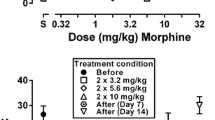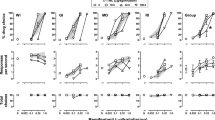Abstract
Rationale
Opioid receptor agonists can enhance some effects of cannabinoid receptor agonists, and cannabinoid receptor agonists can enhance some effects of opioid receptor agonists; however, the generality of these interactions is not established.
Objective
This study examined interactions between the discriminative stimulus and antinociceptive effects of μ opioid receptor agonists and Δ9-tetrahydrocannabinol (THC) in rhesus monkeys.
Results
Neither heroin nor morphine (intravenous (i.v.) or subcutaneous (s.c.)) altered the discriminative stimulus effects of THC in monkeys (n = 5) discriminating 0.1 mg/kg THC i.v. In contrast, THC (s.c.) markedly attenuated the discriminative stimulus effect of morphine and heroin in nondependent monkeys (n = 4) discriminating 1.78 mg/kg morphine s.c. Doses of THC that attenuated the discriminative stimulus effects of morphine in nondependent monkeys failed to modify the discriminative stimulus effects of morphine in morphine-dependent (5.6 mg/kg/12 h) monkeys (n = 4) discriminating 0.0178 mg/kg naltrexone s.c. THC also failed to modify the discriminative stimulus effects of naltrexone in morphine-dependent monkeys or the effects of midazolam in monkeys (n = 4) discriminating 0.32 mg/kg midazolam s.c. Doses of THC (s.c.) that attenuated the discriminative stimulus effects of morphine in nondependent monkeys enhanced the antinociceptive effects of morphine (s.c.) in nondependent monkeys. While μ receptor agonists did not alter the discriminative stimulus effects of THC, THC altered the effects of μ receptor agonists in a context-dependent manner.
Conclusion
That the same doses of THC enhance, attenuate, or do not affect morphine, depending on the condition, suggests that attenuation of morphine by THC can result from perceptual masking rather than common pharmacodynamic mechanisms or pharmacokinetic interactions.


Similar content being viewed by others
References
Bowen CA, Fischer BD, Mello NK, Negus SS (2002) Antagonism of the antinociceptive and discriminative stimulus effects of heroin and morphine by 3-methoxynaltrexone and naltrexone in rhesus monkeys. J Pharmacol Exp Ther 302:264–273
Braida D, Iosuè S, Pegorini S, Sala M (2004) Δ9-Tetrahydrocannabinol-induced conditioned place preference and intracerebroventricular self-administration in rats. Eur J Pharmacol 506:63–69
Breitmeyer BG, Ogmen H (2000) Recent models and findings in visual backward masking: a comparison, review, and update. Percept Psychophys 62:1572–1595
Browne RG (1981) Anxiolytics antagonize yohimbine’s discriminative stimulus properties. Psychopharmacology 74:245–249
Cichewicz DL (2004) Synergistic interactions between cannabinoid and opioid analgesics. Life Sci 74:1317–1324
Colpaert FC (1977) Discriminative stimulus properties of benzodiazepines and barbiturates. In: Lal H (ed) Discriminative stimulus properties of drugs. Plenum, New York, pp 93–106
Cook CD, Beardsley PM (2004) Modulation of the discriminative stimulus effects of mu opioid agonists in rats: II. Effects of dopamine D2/3 agonists. Behav Pharmacol 15:75–83
Doty P, Dykstra LA, Picker MJ (1994) Discriminative stimulus effects of phencyclidine: pharmacologically specific interactions with delta 9- and delta 8-tetrahydrocannabinol. Drug Alcohol Depend 35:151–158
Dykstra LA, Bertalmio AJ, Woods JH (1988) Discriminative and analgesic effects of mu and kappa opioids: in vivo pA2 analysis. Psychopharmacol Ser 4:107–121
France CP, de Costa BR, Jacobson AE, Rice KC, Woods JH (1990) Apparent affinity of opioid antagonists in morphine-treated rhesus monkeys discriminating between saline and naltrexone. J Pharmacol Exp Ther 252:600–604
Gardner EL, Vorel SR (1998) Cannabinoid transmission and reward-related events. Neurobiol Dis 5:502–533
Gauvin DV, Young AM (1989) Evidence for perceptual masking of the discriminative morphine stimulus. Psychopharmacology (Berl) 98:212–221
Gauvin DV, Peirce JM, Holloway FA (1994) Perceptual masking of the chlordiazepoxide discriminative cue by both caffeine and buspirone. Pharmacol Biochem Behav 47:153–159
Gerak LR, Gauthier CR, France CP (2003) Discriminative stimulus and antinociceptive effects of dihydroetorphine in rhesus monkeys. Psychopharmacology 166:351–359
Grant KA (1999) Strategies for understanding the pharmacological effects of ethanol with drug discrimination procedures. Pharmacol Biochem Behav 64:261–267
Greenwald MK, Stitzer ML (2000) Antinociceptive, subjective and behavioral effects of smoked marijuana in humans. Drug Alcohol Depend 59:261–275
Haney M (2007) Opioid antagonism of cannabinoid effects: differences between marijuana smokers and nonmarijuana smokers. Neuropsychopharmacology 32:1391–1403
Haney M, Bisaga A, Foltin RW (2003) Interaction between naltrexone and oral THC in heavy marijuana smokers. Psychopharmacology (Berl) 166:77–85
Justinova Z, Tanda G, Munzar P, Goldberg SR (2004) The opioid antagonist naltrexone reduces the reinforcing effects of Delta 9 tetrahydrocannabinol (THC) in squirrel monkeys. Psychopharmacology (Berl) 173:186–194
Kline FS, Young AM (1986) Differential modification of pentobarbital stimulus control by d-amphetamine and ethanol. Pharmacol Biochem Behav 24:1305–1313
Koek W, Carter LP, Wu H, Coop A, France CP (2006) Discriminative stimulus effects of flumazenil: perceptual masking by baclofen, and lack of substitution with gamma-hydroxybutyrate and its precursors 1,4-butanediol and gamma-butyrolactone. Behav Pharmacol 17:239–247
Li JX, Becker GL, Traynor JR, Gong ZH, France CP (2007) Thienorphine: receptor binding and behavioral effects in rhesus monkeys. J Pharmacol Exp Ther 321:227–236
Li JX, McMahon LR, France CP (2008) Comparison of naltrexone, 6alpha-naltrexol, and 6beta-naltrexol in morphine-dependent and in nondependent rhesus monkeys. Psychopharmacology 195:479–486
Mariathasan EA, White JA, Stolerman IP (1996) Training dose as a decisive factor for discrimination of a drug mixture in rats. Behav Pharmacol 7:364–372
Mariathasan EA, Stolerman IP, White JA (1999) AND and AND-OR drug mixture discriminations in rats: generalization to single drugs and drug mixtures. Psychopharmacology (Berl) 143:54–63
McClure RK (2001) The visual backward masking deficit in schizophrenia. Prog Neuropsychopharmacol Biol Psychiatry 25:301–311
McMahon LR (2006) Characterization of cannabinoid agonists and apparent pA2 analysis of cannabinoid antagonists in rhesus monkeys discriminating Delta9-tetrahydrocannabinol. J Pharmacol Exp Ther 319:1211–1218
National Research Council (2003) Guidelines for the care and use of mammals in neuroscience and behavioral research. National Academies Press, Washington, DC
Navarro M, Carrera MRA, Fratta W, Valverde O, Cossu G, Fattore L, Chowen JA, Gómez R, del Arco I, Villanua Maldonado R, Koob GF, de Fonseca FR (2001) Functional interaction between opioid and cannabinoid receptors in drug self-administration. J Neurosci 21:5344–5350
Negus SS, Gatch MB, Mello NK (1998) Effects of mu opioid agonists alone and in combination with cocaine and D-amphetamine in rhesus monkeys trained to discriminate cocaine. Neuropsychopharmacology 18:325–338
Nencini P, Woolverton WL (1988) Effects of nimodipine on the discriminative stimulus properties of d-amphetamine in rats. Psychopharmacology 96:40–44
Overton DA (1983) Test for a neurochemically specific mechanism mediating drug discriminations and for stimulus masking. Psychopharmacology 81:340–344
Platt DM, Grech DM, Rowlett JK, Spealman RD (1999) Discriminative stimulus effects of morphine in squirrel monkeys: stimulants, opioids, and stimulant-opioid combinations. J Pharmacol Exp Ther 290:1092–1100
Rios C, Gomes I, Devi LA (2006) Mu opioid and CB1 cannabinoid receptor interactions: reciprocal inhibition of receptor signaling and neuritogenesis. Br J Pharmacol 148:387–395
Solinas M, Goldberg SR (2005) Involvement of mu-, delta- and kappa-opioid receptorsubtypes in the discriminative-stimulus effects of delta-9-tetrahydrocannabinol (THC) in rats. Psychopharmacology (Berl) 179:804–812
Solinas M, Panlilio LV, Antoniou K, Pappas LA, Goldberg SR (2003) The cannabinoid CB1 antagonist N-piperidinyl-5-(4-chlorophenyl)-1-(2,4-dichlorophenyl) -4-methylpyrazole-3-carboxamide (SR-141716A) differentially alters the reinforcing effects of heroin under continuous reinforcement, fixed ratio, and progressive ratio schedules of drug self-administration in rats. J Pharmacol Exp Ther 306:93–102
Solinas M, Zangen A, Thiriet N, Goldberg SR (2004) Beta-endorphin elevations in the ventral tegmental area regulate the discriminative effects of Delta-9-tetrahydrocannabinol. Eur J Neurosci 19:3183–3192
Solinas M, Panlilio LV, Tanda G, Makriyannis A, Matthews SA, Goldberg SR (2005) Cannabinoid agonists but not inhibitors of endogenous cannabinoid transport or metabolism enhance the reinforcing efficacy of heroin in rats. Neuropsychopharmacology 30:2046–2057
Stolerman IP, White JA (1996) Impact of training history on discrimination of a drug mixture by rats. Behav Pharmacol 7:483–494
Stolerman IP, Mariathasan EA, White JA (1999) Influencing the specificity of drug mixture discriminations by varying the training procedure. Behav Pharmacol 10:657–664
Tanda G, Goldberg SR (2003) Cannabinoids: reward, dependence, and underlying neurochemical mechanisms–a review of recent preclinical data. Psychopharmacology (Berl) 169:115–134
Wachtel SR, de Wit H (2000) Naltrexone does not block the subjective effects of oral Delta(9)-tetrahydrocannabinol in humans. Drug Alcohol Depend 59:251–260
Wegel RL, Lane CE (1924) The auditory masking of one pure tone by another and its probable relation to the dynamics of the inner ear. Physiol Rev 23:266–285
Welch SP, Eads M (1999) Synergistic interactions of endogenous opioids and cannabinoid systems. Brain Res 848:183–190
Wiley JL (1999) Cannabis: discrimination of “internal bliss”. Pharmacol Biochem Behav 64:257–260
Young AM, Masaki MA, Geula C (1992) Discriminative stimulus effects of morphine: effects of training dose on agonist and antagonist effects of mu opioids. J Pharmacol Exp Ther 261:246–257
Acknowledgements
The authors thank Christopher Cruz, Blake Harrington, Brandi Taylor, Armando Hernandez, and Ashley Varnon for expert technical assistance.
Author information
Authors and Affiliations
Corresponding author
Additional information
Miscellaneous
This work was supported by USPHS Grants DA05018 (CPF), DA09157 (CPF), DA15468 (LRM), and DA19222 (LRM); CPF is supported by a Senior Scientist Award (DA17918). The authors have no other financial relationships with any organization that is relevant to the results presented in this manuscript.
Rights and permissions
About this article
Cite this article
Li, JX., McMahon, L.R., Gerak, L.R. et al. Interactions between Δ9-tetrahydrocannabinol and μ opioid receptor agonists in rhesus monkeys: discrimination and antinociception. Psychopharmacology 199, 199–208 (2008). https://doi.org/10.1007/s00213-008-1157-0
Received:
Accepted:
Published:
Issue Date:
DOI: https://doi.org/10.1007/s00213-008-1157-0




